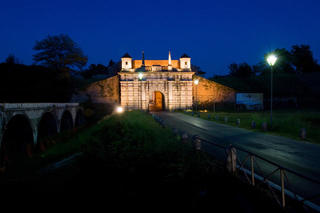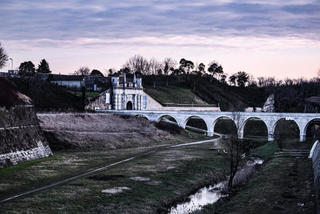
Porta Udine
Porta Udine, one of the three possible entrances to the fortress city, takes its name from the destination to which it leads. Built between 1604 and 1605, it still preserves the two large wheels used to raise and lower the drawbridge. The monumental facade features two lateral semi-columns and, above the cornice, two spires and two guard sentry boxes. Inside, there is a courtyard with two arcades equipped with fireplaces and rooms for the accommodation of the garrison on guard duty.
Outside the gate, the large aqueduct in white stone is visible, a reconstruction from 1751 in neoclassical style.
The first structure was built in the mid-17th century for the water supply inside the fortress.
Like the other two gates, it was defended by a drawbridge, gates, and imposing equipped doors: every evening it was raised, making the fortress impregnable.

The Waterfall near Porta Udine
Approximately 3 meters high, it was restored in 2015, along with the short canal built by Venetian craftsmen in bricks with a dry-laid stone bottom.
A stone basin located at the base of the two locks was also uncovered, forming an element in the fascinating water transport system that remains mysterious in many ways even today.
A tunnel, corresponding to the arches of the aqueduct, has not yet revealed its origin and meaning: when the flow is opened, water is seen to emerge first from the rectangular hole and then from the waterfall.

The Venetian Aqueduct
Outside Porta Udine stands the mighty structure of the Venetian Aqueduct.
The construction dates back to the origins of the fortress.
It was restored several times: in 1665 Provveditore Alvise Molin had it almost completely rebuilt using Medea stone, but it assumed its current form only in 1771. The aqueduct was used to carry the water from the Roggia di Palma inside the fortress for civic use. The plaque at the center of the work, built by the Palmarino Carlo Pico in 1751, represents a lion's skin between two allegorical female figures, Igea and the Source. It contains a laudatory epigraph of Provveditore Pisani.
In 2013, it was completely restored by the Soprintendenza.


